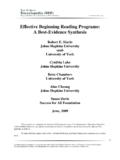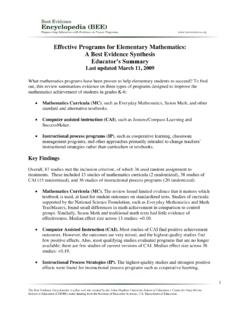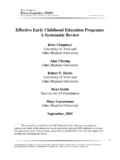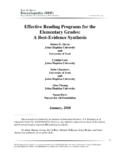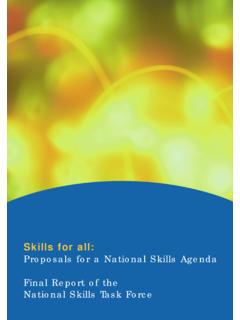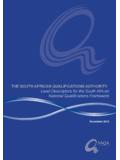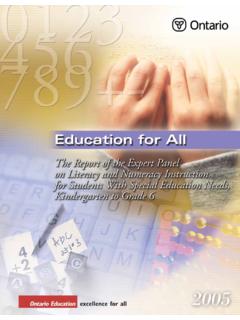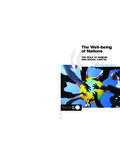Transcription of Literacy and Language Outcomes of …
1 Literacy and Language Outcomes of Comprehensive and Developmental-Constructivist Approaches to Early Childhood Education: A Systematic Review Bette Chambers University of York Alan C. K. Cheung The Chinese University of Hong Kong Robert E. Slavin Johns Hopkins University March, 2016. 1. The Best Evidence Encyclopedia is a free web site created by the Johns Hopkins University School of Education's Center for Data-Driven Reform in Education (CDDRE) under funding from the Institute of Education Sciences, Department of Education. Abstract This systematic review of research on early childhood programs seeks to identify effective approaches capable of improving Literacy and Language Outcomes for preschoolers.
2 It applies consistent standards to determine the strength of evidence supporting a variety of approaches, which fell into two main categories: comprehensive approaches, which include phonemic awareness, phonics, and other skills along with child-initiated activities, and developmental-constructivist approaches that focus on child-initiated activities with little direct teaching of early Literacy skills. Inclusion criteria included use of randomized or matched control groups, evidence of initial equality, a minimum study duration of 12 weeks, and valid measures of Literacy and Language .
3 Thirty-two studies evaluating 22 programs found that comprehensive early childhood programs that have a balance of skill-focused and child-initiated activities programs had significant evidence of positive Literacy and Language Outcomes at the end of preschool and on kindergarten follow-up measures. Effects were smaller and not statistically significant for developmental-constructivist programs. Key words/phrases: early childhood programs, preschool teaching methods, emergent Literacy , Head Start, systematic reviews 2. The Best Evidence Encyclopedia is a free web site created by the Johns Hopkins University School of Education's Center for Data-Driven Reform in Education (CDDRE) under funding from the Institute of Education Sciences, Department of Education.
4 Literacy and Language Outcomes of Comprehensive and Developmental-Constructivist Approaches to Early Childhood Education: A Systematic Review 1. Introduction Early childhood education, particularly preschool education for three- and four-year-olds, can have a lasting impact on the educational success and life chances of disadvantaged children. Numerous reviews of longitudinal studies have found that in comparison to children who do not attend preschool at all, high-quality preschool experiences have strong impacts on cognitive Outcomes at the end of preschool, and these effects can last into elementary and secondary school and beyond ( , Authors, 2006; Authors, 2013; Camilli, Vargas, Ryan, & Barnett, 2009.)
5 Coghlan et al., 2009; Gorey, 2001; Jacobs, Creps, & Boulay, 2004; Nelson, Westhues, &. MacLeod, 2003; Waldfogel & Washbrook, 2010). Even though the types of programs with long- lasting impacts are far more intensive and extensive than ordinary early childhood programs, these long-term impacts for very disadvantaged children make intensive programs highly cost- effective in the long run (Carneiro & Heckman, 2003; Heckman & Masterov, 2007; Karoly, Kilburn, &Cannon, 2005). In particular, programs like the Perry Preschool (Schweinhart &. Weikart, 1997) and the Abecedarian Project (Ramey & Ramey, 1998) are frequently held up as models of what early childhood education could be.
6 The evaluation of these and other intensive models are important in demonstrating that disadvantage can be overcome with intensive and comprehensive intervention, involving children, families, health, and social factors (see Gorey, 2001). However, evaluations of Head Start in the , Sure Start in the , and other run-of-the-mill preschool models have shown strong immediate impacts but not the lasting effects documented for some of the intensive models (Camilli et al., 2009; Melhuish, Belsky, & Leyland, 2010). For example, a large-scale national randomized evaluation of Head Start (Puma, Bell, Cook, & Heid, 2010) found positive impacts on several measures at the end of the preschool year that were fading by the end of kindergarten and gone by the end of first grade.
7 This pattern closely matches findings from the recent large-scale randomized evaluation of the Tennessee Voluntary Prekindergarten Program (Lipsey, Hofer, Dong, Farran, & Bilbrey, 2013 a, b), a long- term evaluation of early childhood programs in Australia (Claessens, & Garrett, 2014), a follow- up to age 5 of Sure Start in the (Melhuish et al., 2010) and long-term studies in England of preschool programs for three year olds (Belsky & Melhuish, 2007; Brewer, Cattan, Crawford, &. Rabe, 2014), as well as many earlier studies (see Karweit, 1994). The disappointing findings of these evaluations of ordinary preschool programs, coupled with political support for expanding and improving preschool experiences, have led to a search for pragmatic strategies capable of improving immediate and lasting impacts of preschool for disadvantaged children.
8 In particular, interest has moved from studies of preschool vs. no preschool to evaluations of alternative approaches to preschool education (Diamond, Justice, Siegler, & Snydor, 2013). Previous reviews ( , Camilli et al., 2009; Jacob et al., 2004) have reviewed effects of alternative programs, but only cited studies published up to 2000. A great 3. The Best Evidence Encyclopedia is a free web site created by the Johns Hopkins University School of Education's Center for Data-Driven Reform in Education (CDDRE) under funding from the Institute of Education Sciences, Department of Education.
9 Deal of experimental research comparing different preschool approaches has taken place since 2000. This review considers the evidence on alternative strategies for use in preschool in terms of Language and Literacy Outcomes , measured at the end of the preschool and kindergarten years, synthesizing findings of studies of contrasting approaches that were published from 1990 to 2015. Theoretical and Historical Background From the beginning, preschools have had a primary emphasis on socialization and general cognitive development. In the transition from home to school, children have long been encouraged to play, sing, build with blocks, and do art, dress-up, and drama.
10 The theories of Piaget (1952) and Vygotsky (1987) strongly reinforced the idea that cognitive and social development were the appropriate goals of early childhood education and that self-chosen activities, interactions among children, and experience with make-believe, construction, art, and music were the key to cognitive and social development. Approaches of this kind are called inquiry-based or as using constructivist principles by Camilli et al. (2009) and developmentally appropriate by the National Association for the Education of Young Children (Neuman, Copple, & Bredekamp, 1999) and many others.
